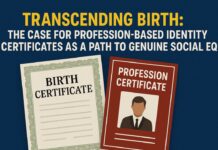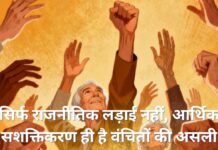Caste: Humanity’s Greatest Scam and Tool of Oppression
Caste is arguably the most insidious social construct in human history. It’s a system of hierarchical social stratification characterized by hereditary transmission of a lifestyle which often includes an occupation, a status in a social hierarchy, and customary social interaction. In simpler terms, it’s a system where one’s social standing is determined at birth, and it permeates every aspect of life, regardless of individual merit.
As I see it, the diabolical nature of caste lies in how it operates as a tool for those seeking to assert dominance. A person with no tangible achievements, no education, and no knowledge can use their caste identity to claim superiority over others. This inherent injustice is the core of the scam. This system has been prevalent in the Indian subcontinent for centuries, with roots in ancient texts and colonial policies that further entrenched social divisions.
The Mechanics of Humiliation and Superiority
Caste becomes a tool for those who have nothing else to offer. In societies plagued by caste systems, people lacking talent, education, or genuine accomplishments often find a perverse sense of self-worth in their inherited social status. They use it to:
- Humiliate: Demeaning and insulting individuals from lower castes becomes a way to reinforce their own false sense of superiority. This humiliation has taken many forms throughout history, including public shaming, social ostracization, and even violence.
- Assert Dominance: Caste provides a ready-made framework for exerting control and power over others, perpetuating inequality. This dominance manifests in the unequal distribution of resources, opportunities, and political power.
- Deny Merit: The system disregards individual capabilities, knowledge, and talent. A highly skilled person from a lower caste may be systematically denied the opportunities and recognition they deserve, while someone from a higher caste, regardless of their incompetence, is elevated. This inefficiency harms not only individuals but also society as a whole.
It’s a particularly twisted irony that even within the traditional hierarchy, some groups categorized in the lower rungs still perpetuate this cycle of oppression. They cling to a false sense of superiority over those deemed even lower, highlighting how deeply ingrained and self-serving these beliefs are. This phenomenon underscores the complexities and obstacles to social mobility.
Moreover, caste bias extends into institutional practices in ways that are difficult to prove or legally challenge. For instance, in scenarios such as hiring within government organizations, a higher caste may, even unconsciously, favor a candidate from their own caste. This can occur under the guise of legitimate reasons, such as “better fit” or “stronger communication skills,” effectively masking the underlying caste bias.
While such actions may be technically legal, they are deeply unethical and perpetuate systemic inequality by undermining the principles of meritocracy and fair competition. This subtle form of discrimination makes it incredibly difficult to address, as it operates beneath the surface of explicit policies and regulations. Notably, this pattern was evident in the early post-independence era, where individuals who gained access to higher education and government positions often used their influence to benefit their own caste networks.
This created a self-perpetuating cycle of advantage, where early beneficiaries helped entrench the dominance of their caste groups within key institutions. It is important to emphasize that this is not a problem limited to a single group; rather, it is a systemic issue that can manifest across different castes and communities.
This pattern is further exacerbated when individuals with casteist leanings rise to positions of power within government and planning bodies. These higher caste officials may then disproportionately allocate resources and development projects to areas dominated by their own caste, leading to the economic upliftment of their caste group.
This, in turn, can provide them with access to better education and opportunities, perpetuating a cycle of advantage that reinforces their dominance within the system. A particularly insidious aspect of this is the manipulation of land purchases and development projects. Officials, acting as planners, may strategically acquire land in areas predominantly inhabited by their own caste, often under the guise of public development or infrastructure projects. This land is then developed in a way that primarily benefits their caste group, either through preferential allocation of housing, commercial spaces, or amenities.
This not only enriches their caste group but also further marginalizes others, perpetuating a cycle of economic and social disparity. Compounding this, these officials may also exploit their positions by leaking information about planned land acquisitions to members of their own caste. This allows them to purchase the land at lower prices before it is officially acquired by the government, only to later sell it back at a significantly inflated price, thus reaping substantial financial gains.
This blatant abuse of power for personal enrichment and caste-based favoritism further entrenches economic inequality and erodes trust in public institutions. This cycle, driven by the misuse of power and influence, has been observed in similar patterns across post-independence India, demonstrating how initial advantages can be leveraged to perpetuate systemic inequality across generations, and across various groups.
The denial of justice to lower-caste individuals is a particularly egregious example of this systemic oppression. To illustrate, consider a scenario where a lower-caste person is murdered by a member of a higher caste.
The victim’s family, in seeking justice, faces numerous obstacles. They may find that the police, influenced by caste bias (perhaps the police inspector is from the same caste as the offender), refuse to register a First Information Report (FIR). The family is then forced to struggle and fight simply to get the case formally acknowledged.
Further, the offender, leveraging his caste connections, may assemble a group of his caste members to pressure the victim’s family, intimidating them into not pursuing the case. Even if an FIR is eventually registered, the challenges continue. The public prosecutor, who may also be from the offender’s caste, might subtly undermine the prosecution.
The defense attorney, similarly, could be from the offender’s caste, creating a situation where the accused receives undue benefits. This example demonstrates the systemic barriers that lower-caste individuals face in seeking justice, where caste loyalties can override legal and ethical obligations at every stage of the process.
However, if a particular caste, historically disadvantaged, seeks to escape this cycle, a strategic focus on internal unity and economic upliftment becomes crucial. This involves:
- Caste Unity: Organizing and mobilizing the community to act collectively, fostering a sense of shared identity and purpose. This can translate into political mobilization, social support networks, and collective bargaining power.
- Economic Upliftment: Prioritizing economic development within the community. This could involve promoting entrepreneurship, investing in education and skills training, and creating cooperative economic ventures. A key aspect of this is also focusing on gaining knowledge about finances, the history of their own caste, and helping others within the community financially.
By focusing on these areas, a caste group can begin to break the cycle of disadvantage and create a more level playing field for its members.
The Tragedy of Lost Potential
Caste is not just a social evil; it’s a colossal waste of human potential. It stifles innovation, hinders progress, and perpetuates cycles of poverty and marginalization. When a society values birth over merit, it deprives itself of the contributions of countless talented individuals. This clash of caste not only hampers the social fabric of a nation but also affects its economic potential and standing in the international arena. On the economic front, a society divided by caste:
- Limits the Talent Pool: Prevents the most qualified individuals from accessing key positions, reducing productivity and innovation. This inefficiency harms businesses, industries, and the nation’s overall economic output.
- Discourages Investment: Creates instability and uncertainty, deterring both domestic and foreign investment. Investors are wary of societies plagued by social unrest and inequality.
- Perpetuates Inequality: Widens the gap between the rich and poor, leading to social unrest and hindering economic growth. This disparity fuels resentment and instability, further hindering progress.
In addition, caste discrimination can also negatively impact international relations, affecting trade agreements, cultural exchange, and diplomatic ties.
Breaking Free from the Scam
The fight against caste is a fight for:
- Equality: Recognizing the inherent worth and dignity of every human being, regardless of their birth. This is not merely an idealistic goal but a fundamental human right.
- Meritocracy: Creating a society where opportunities and rewards are based on ability, talent, and hard work. This ensures that everyone has a fair chance to succeed.
- Justice: Dismantling the structures that perpetuate caste-based discrimination and ensuring that everyone has an equal chance to succeed. This requires legal reforms, social programs, and grassroots activism.
Caste is a deeply entrenched problem, but it is not insurmountable. By acknowledging its inherent injustice and actively working to dismantle it, we can create a world where true worth, not the accident of birth, determines a person’s standing. This is a long and arduous struggle, but it is a battle that must be won.



















